Vascular Wound Care Specialist in Los Angeles
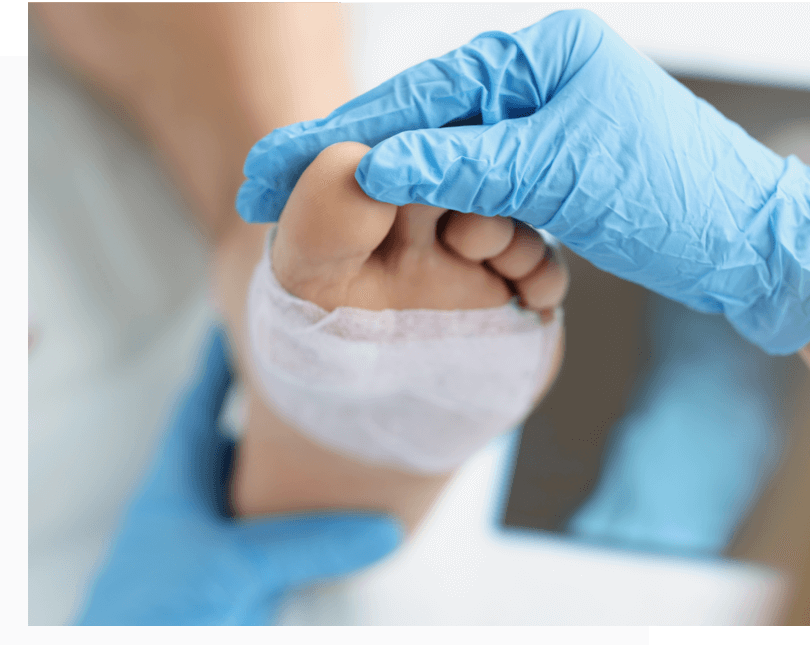
Non-healing wounds usually form on the back of the lower leg between the calf and ankle, causing itchiness, leg pain, and skin discoloration. While it’s true that these wounds can be caused by injury or other conditions like diabetes, chronic lower extremity wounds that take more than 2 weeks to heal or that lead to progressively worsening skin breakdown are more than likely attributable to underlying vascular disease, and therefore benefit significantly from vascular wound care. In fact, vascular disease contributes to more than 90% of chronic wounds.
Obstructed blood flow is the unifying disease process in many vascular diseases, underpinning peripheral artery disease (PAD) in the arteries, chronic venous insufficiency wounds (CVI) in the veins, and a number of other localized vascular conditions like May-Thurner Syndrome and venous thromboembolism. Throughout the course of several years, these diseases disrupt blood flow to tissues, eventually damaging skin, muscles, and nerves due to lack of adequate blood supply. Over 8.5 million people in the US suffer from PAD and more than 6 million live with CVI [1,2].

Vascular Wound Care & Treatment in Los Angeles
Experienced Wound Care Specialists
Timely, accessible wound care is paramount in the effort against arterial wounds, venous wounds, and their complications.
Dr. Michael Lalezarian is a double-board certified Vascular Interventional Radiologist specializing in minimally invasive endovascular arterial revascularization. He is a committed partner in the battle against the devastating consequences of advanced vascular disease.
Terry T, October 2022
Arterial Wound vs Venous Wound
Skin ulceration can occur when either veins, arteries, or both malfunction. Many are surprised to learn that venous insufficiency contributes to approximately 70% of vascular wounds, while arterial disease accounts for 5 to 10%. At the same time, as many as 26% of leg ulcers have both venous and arterial causes [3,4]. Learn about the causes between arterial wounds vs venous wounds below.
Causes of Arterial Wounds
Causes of Venous Wounds
Ultimately, CVI results in limited blood flow toward the heart. Without the ability to return blood back to the body’s main circulatory pump, blood pools in the extremities and backs up in the veins. The increased blood volume surpasses the veins’ natural reservoir capacity and exerts increased pressure on the vessels, causing undue stress and eventual failure. As more of the venous system is affected and blood flow is further compromised, skin color changes in the lower leg and wounds form as tissue breaks down. Risk factors for venous wound formation include: older age, sedentary lifestyle, high body mass index, arterial hypertension, deep vein thrombosis, deep vein reflux, and a family history of venous leg wounds [6].
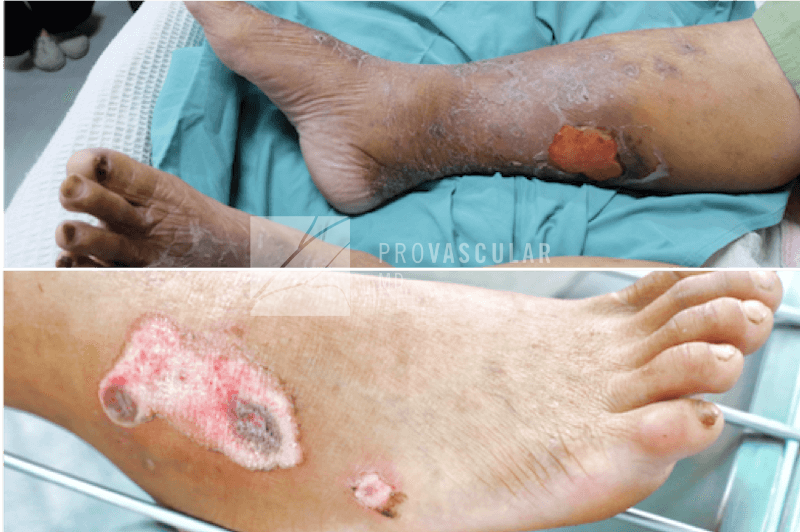
Signs & Symptoms of Vascular Wounds
Arterial Wounds
Arterial wounds typically develop over bony parts of the foot as well as the heels and toes, past the point of vessel occlusion. These can be shallow or deep skin wounds with or without gangrene. Arterial wounds have well-defined edges and appear to be “punched out.” The center of the wound, the wound base, is pale in color (grey or yellow). Skin surrounding the arterial wound may be red, cold to the touch, shiny, and hairless [7].
Venous Wounds
As vein disease increases in severity, constant swelling, fat destruction (lipodermatosclerosis), and skin discoloration and deterioration occur anywhere between the knee and ankle [4, 7-9]. Appearance-wise, the skin surrounding the wound looks shiny, thin, hairless, and hyperpigmented with a brown color. The wound itself has sloping edges, and exudate fluid may ooze from the wound. Venous wounds are shallow and irregularly shaped. Pain is usually less severe compared to arterial wounds unless there is an active infection or excessive swelling.
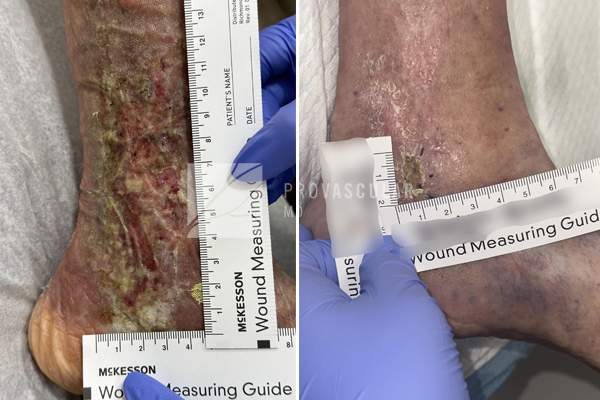
Care & Treatment for Vascular Wounds
Treatment for vascular wounds isn’t just about addressing the visible leg ulcer, but also the underlying disease process that created them in the first place. The root cause of arterial and venous wound formation is vascular disease such as advanced peripheral artery disease and chronic venous insufficiency. However, many lower extremity wounds have a multifactorial set of causes (in addition to vascular disease), and therefore require multiple, simultaneous treatment approaches.
A multidisciplinary team consisting of wound care specialists, podiatrists, physical therapists, primary care physicians, and vascular interventionalists will provide the best care for a patient suffering from venous or arterial leg ulcerations attributable to vessel disease [2-3,10]. Vascular interventionalists include general and vascular surgeons, who are best-suited to treat advanced vessel disease through invasive surgeries. They also include interventional radiologists, who specialize in minimally invasive approaches to improve blood flow.

Arterial Wound Care & Treatments
Lifestyle Changes and Medicine
Arterial Wound Care
Patients who present with open, non healing arterial wounds are typically referred to a wound doctor who will clean the wound routinely and dress it with bandages to prevent infection and promote healing of the skin. Arterial wound dressing changes do not target the underlying arterial disease that causes the wounds, however, arterial wound care is still an essential part of healing and complements other treatments.
Minimally Invasive Revascularization
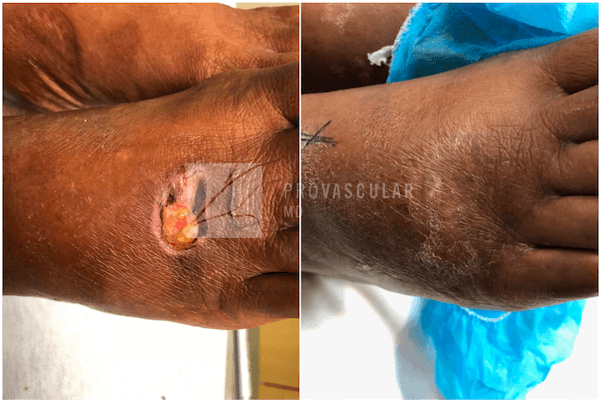
Your Partner in Vascular Care
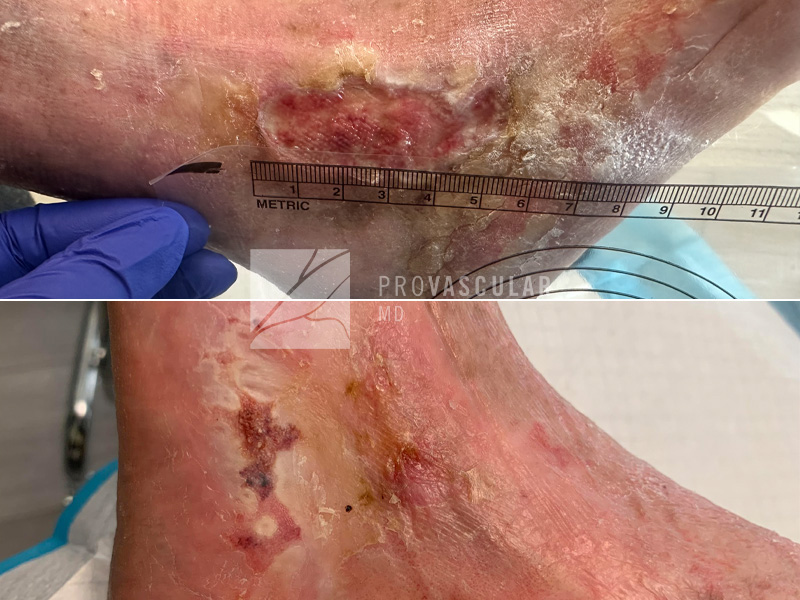
Venous Wound Care & Treatments
Compression Stockings
Venous Wound Care
Patients who present with open, non healing venous wounds are typically referred to a wound care specialist who will clean the wound routinely and dress it with bandages to prevent infection and promote healing of the skin. Changes to the wound dressing for venous leg ulcers do not target the underlying vein disease that causes venous ulceration, however, venous wound care is still an essential part of healing and complements other treatments.
Superficial Vein Closure
Deep Vein Revascularization
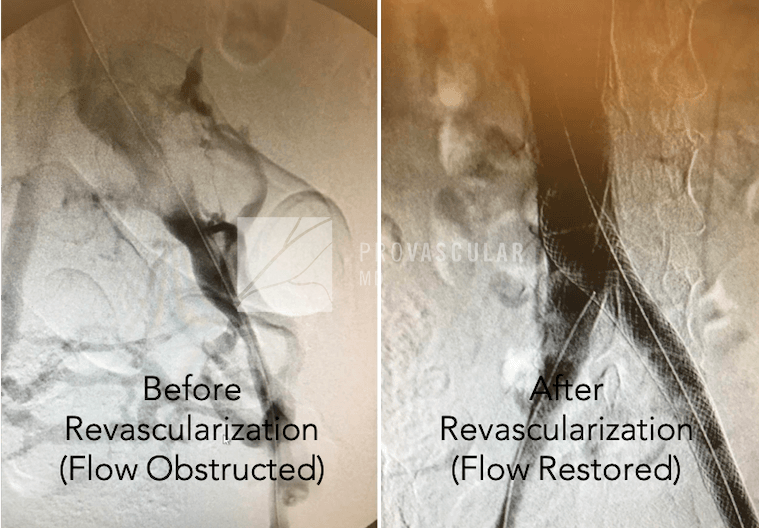
Vascular Wound Care Specialist in Los Angeles
At ProVascularMD, we provide minimally invasive wound care, both arterial wound treatment and venous wound treatment. Our vascular and interventional radiologists specialize in revascularization techniques to treat peripheral artery disease, and vein closure treatment for venous insufficiency. Give us a call today to schedule your visit at our vascular wound care center in Los Angeles!
Lower Extremity Arterial Disease
Peripheral Arterial Disease Treatment
What Are Arterial Ulcers?
Vascular Specialist in Los Angeles
Learn more about Los Angeles Vascular Specialist Dr. Michael Lalezarian.
[1] Peripheral Arterial Disease (PAD) Fact Sheet. Centers for Disease Control and Prevention; 2016. https://www.cdc.gov/dhdsp/data_statistics/fact_sheets/fs_pad.htm. Accessed November 25, 2019.
[2] Patel SK, Surowiec SM. Venous Insufficiency. In: StatPearls. Treasure Island (FL): StatPearls Publishing; 2019. http://www.ncbi.nlm.nih.gov/books/NBK430975/. Accessed November 25, 2019.
[3] Agale SV. Chronic Leg Ulcers: Epidemiology, Aetiopathogenesis, and Management. Ulcers. 2013;2013:1-9.
[4] Hedayati N, Carson JG, Chi Y-W, Link D. Management of mixed arterial venous lower extremity ulceration: A review. Vasc Med. 2015;20(5):479-486.
[5] Shu J, Santulli G. Update on peripheral artery disease: Epidemiology and evidence-based facts. Atherosclerosis. 2018;275:379-381.
[6] Meulendijks AM, de Vries FMC, van Dooren AA, Schuurmans MJ, Neumann HAM. A systematic review on risk factors in developing a first‐time Venous Leg Ulcer. J Eur Acad Dermatol Venereol. 2019;33(7):1241-1248.
[7] Grey JE, Harding KG, Enoch S. Venous and arterial leg ulcers. BMJ. 2006;332(7537):347-350.
[8] Salcrido, R. C. Arterial vs Venous Ulcers: Diagnosis and Treatment: Advances in Skin & Wound Care. 2001;14(3):146-147.
[9] Dean SM. Cutaneous Manifestations of Chronic Vascular Disease. Progress in Cardiovascular Diseases. 2018;60(6):567-579.
[10] Foy White-Chu E, Conner-Kerr TA. Overview of guidelines for the prevention and treatment of venous leg ulcers: A US perspective. J Multidiscip Healthc. 2014;7:111-117. doi:10.2147/JMDH.S38616
[11] Meissner (2016). What is effective care for varicose veins? Phlebology, 31(1_suppl), 80–87.
[12] Gohel (2018). A Randomized Trial of Early Endovenous Ablation in Venous Ulceration. New England Journal of Medicine, 378(22), 2105–2114.
[13] Kankam (2017). A summation analysis of compliance and complications of compression hosiery for patients with chronic venous disease or post-thrombotic syndrome. European Journal of Vascular and Endovascular Surgery, 55:406-416.
[14] Lohr (2010). Radiofrequency Ablation: Evolution of a Treatment. Seminars in Vascular Surgery, 23(2), 90–100.
Schedule Your Visit
Click the Chat Button
Vascular Care in Los Angeles
& San Bernardino County
Adelanto
Alhambra
Amboy
Angelus Oaks
Apple Valley
Arcadia
Azusa
Baker
Baldwin Park
Barstow
Bell Gardens
Big Bear City
Big Bear Lake
Bloomington
Blue Jay
Bryn Mawr
Burbank
Cedar Glen
Cedarpines Park
Chino
Chino Hills
Cima
Citrus
City of Industry
Claremont
Colton
Covina
Crestline
Daggett
Diamond Bar
Downey
Duarte
Eagle Rock
Earp
El Monte
Essex
Fawnskin
Fontana
Forest Falls
Fort Irwin
Glendale
Glendora
Grand Terrace
Green Valley Lake
Guasti
Hacienda Heights
Helendale
Hesperia
Highland
Highland Park
Hinkley
Irwindale
Joshua Tree
La Canada
La Crescenta
La Habra
La Mirada
La Puente
La Verne
Lake Arrowhead
Landers
Loma Linda
Lucerne Valley
Ludlow
Lytle Creek
Mentone
Monrovia
Montclair
Montebello
Monterey Park
Morongo Valley
Mountain Pass
Mt Baldy
Needles
Newberry Springs
Nipton
Norwalk
Ontario
Oro Grande
Parker Dam
Pasadena
Phelan
Pico Rivera
Pinon Hills
Pioneertown
Pomona
Rancho Cucamonga
Redlands
Rialto
Rimforest
Rosemead
Running Springs
San Bernardino
San Dimas
San Gabriel
Santa Fe Springs
Sierra Madre
Skyforest
South El Monte
South Pasadena
Sugarloaf
Temple City
Trona
Twentynine Palms
Twin Peaks
Upland
Victorville
Vidal
Walnut
West Covina
West San Dimas
Whittier
Wrightwood
Yermo
Yucaipa
Yucca Valley





